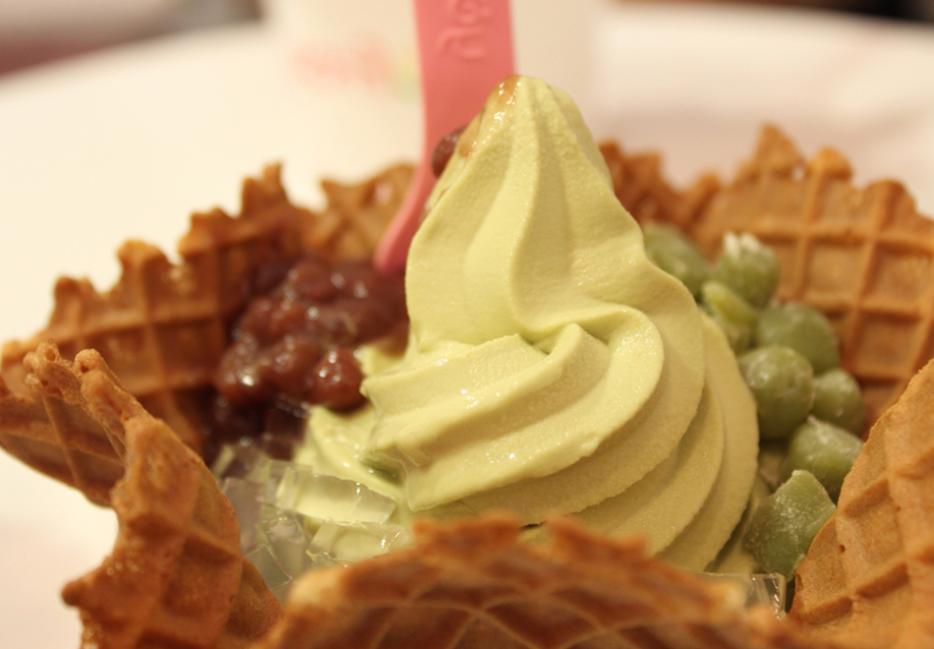I was six, maybe seven, sitting at the kitchen table with my parents and my younger brother. It was a hot summer afternoon, and my mother was standing by the open fridge.
“What kind of yogurt do you want David?” she asked.
“I want plain mocha with strawberry.”
“What?”
“Plain mocha with strawberry.”
“What’s plain mocha?”
“Mocha yogurt, the one I like, the plain one.”
“Mocha yogurt isn’t plain, it’s mocha flavour David. What do you want?”
“I want plain mocha yogurt with strawberry!”
“What?”
“PLAIN MOCHA WITH STRAWBERRY!”
What could the poor woman do? She took out a tub of Liberté mocha flavoured yogurt, another tub of strawberry, spooned equal portions of them into my bowl, and set it in front of me. I looked down at the brown and pink mess, confused. Was this what I wanted? I took a spoonful and realized that no, this was not what I wanted. Rather, it was a hideous marriage of bigger brown and bright beautiful pink, of coffee and fruit, of unholy and sacred. I spat it back in the bowl and started screaming.
“I wanted plain! Plain mocha! Wahhhhhhh! Plain mocha yogurt!”
A half hour later, after my crying fit subsided, I was in my mother’s arms, apologizing as the tears crystallized on my cheeks. Out of this dairy disaster, I learned a valuable lesson. Mocha, it turns out, was a word for food that tasted like coffee, and what I really wanted was plain Liberté brand yogurt, which I just assumed was called mocha, because we ate a lot of mocha yogurt. Keep in mind that it was the mid-1980’s, a very confusing time in the evolution of the yogurt trend.
I looked down at the brown and pink mess, confused. Was this what I wanted? I took a spoonful and realized that no, this was not what I wanted.
Food trends are powerful cultural forces that shape what we eat, affecting everything from the politics of agriculture, to the economics of the supermarket. But as I’ve discovered over the course of the past few years, as I wrote a book about their evolution (The Tastemakers: Why We’re Crazy for Cupcakes but Fed Up With Fondue), they are also intensely personal. What we’re eating now is as culturally relevant as the clothes we’re wearing, the song on the radio, and the TV series we are binge watching. Food trends succeed because they reflect what is going on in our world. Without the sexual revolution of the 1970’s fondue would have remained a rustic Swiss alpine dish. The great sushi trend of the 1980’s had as much to do with the Toyota Camry in our driveways and the Nintendo Entertainment System plugged into our Sony TV, than it did with a love of raw fish and the wizardry of chefs like Nobu Matsuhisa. These strong associations make it possible for food trends to weave in and out of our lives, a recurring taste memory, rich with nostalgia, that always seems to take the form of yogurt, in my own life.
I was born during the first era of big yogurt. Prior to the 80’s, yogurt was a sour, watery substance eaten mostly in ethnic communities and by hippies who shopped at health food stores that smelled like old cats. Because it had calcium (which was the antioxidant of its day), and because it was relatively low in fat (fat being the devil of the 80’s), yogurt became an acceptable indulgence. There were yogurts with little puddles of fruit on the bottom, some with fruit on the top, others with two swirls of fruit cutting through them, and even non-fruit flavours, like mocha, which made yogurt somehow adult and sophisticated. Yogurt was everywhere in that era: mixed with cereal for breakfast, sitting in my lunchbox next to a tuna sandwich, served as an afternoon snack with fruit or nuts, or as a dipping destination for cookies, if milk wasn’t handy.
Then there was frozen yogurt. I remember the first time we had it, at a newly opened TCBY, a blessed, omnivorous titan of corporate frozen yogurt that ruled the continent during the peak of the froyo trend. We looked up at a big board with all sorts of ingredients: every possible type of fruit, the name of each and every candy bar, all of which had been cubed, crushed, and frozen, to be reassembled in the frozen yogurt machine. Standing tall and gleaming in brushed stainless steel, that machine was both awe inspiring and fearsome. The TCBY staff lined up in front of it, feeding the machine the ingredients you’d selected, along with a small brick of frozen sour yogurt, like they were offering tribute to a sacred volcano. With one hand on the cone, they would pull the lever, almost like the thing was a giant slot machine, and the great frogurt contraption would growl to life, shaking the very floor under your feet, until it finally pooped out (really, there’s no other way to describe this) a perfect swirl of frozen yogurt in the exact flavour you wanted.
What we’re eating now is as culturally relevant as the clothes we’re wearing, the song on the radio, and the TV series we are binge watching. Food trends succeed because they reflect what is going on in our world.
For me, frozen yogurt was at its peak in a freshly rolled out waffle cone, in the few precious days between school and summer camp, when the sidewalk by my neighbourhood frozen yogurt shop, the Village Chill, was a mob scene of kids, parents, dogs, bikes, and in-line skates. The queue stretched down to the corner, and as you worked your way up, chatting and joking and feeling that early summer sun on the back of my neck, I dreamed up what combination today’s cone would hold. Would I be somewhat virtuous and fruity, maybe going for the tart kick of mango and raspberry? Or would I just cave to the Oreo/banana combo, which had become my default?
All food trends have a lifespan, and anyone who has experienced their rise, also must taste their fall. What was new and novel loses its freshness, and we start searching for new tastes. By the 1990’s frozen yogurt had overplayed its hand, as most food trends tend to. Riding in on the greater trend of low-fat indulgences, the fruit based froyo increasingly grew supersized, and its virtuousness was buried under a weight of brownies, chocolate fudge, and whipped cream combinations. There was a great Seinfeld episode that captured this moment as it began to slide downhill. Newman and his fellow mailmen are living it up on fat-free yogurt, calling for another round of strawberry, like salesmen at a watering hole, but doom is around the corner.
Frozen yogurt moved off main street to the back of the supermarket freezer. In those big tubs it looked the same as ice cream, but tasted far worse, with none of the magic that was present when it was cranked out fresh. Regular yogurt also struggled. With its fat reduced to zero, yogurt makers had to introduce all sorts of chemicals to improve mouthfeel and texture, and masked this with increasingly aggressive flavours. No longer was strawberry sufficient. Now it was about dulce de leche and New York cheesecake and banana cream pie yogurts. It was all reduced to an exercise in corporate tinkering, as big yogurt did what they could to scramble for market share. Yogurt on the go, yogurt with cookie crumble on top, yogurt in a tube, yogurt as a drink, something called GoGurt…and on and on until yogurt was just a vehicle for corn syrup… a health food turned junk food.
By the time I hit university in early 2000’s, I still ate yogurt, but mostly it was at breakfast, with granola, like the hippie forefathers did. I watched from the sidelines as the yogurt companies did whatever they could do bring it back. On one end of the spectrum they held it up as a decadent indulgence, showing TV ads of slender women at their desks, peeling back the top on their luscious, rich cappuccino yogurt snack. On the other, you had Jamie Lee Curtis extolling Activia as a wonderful laxative for baby boomers. No longer a trend, yogurt was searching for its very soul.
For me, frozen yogurt was at its peak in a freshly rolled out waffle cone, in the few precious days between school and summer camp, when the sidewalk by my neighbourhood frozen yogurt shop, the Village Chill, was a mob scene of kids, parents, dogs, bikes, and in-line skates.
Eventually, yogurt went back to its roots, by way of Greece. When I moved to New York in 2008, I noticed a significant chunk of the yogurt case taken up by a fast growing brand called Fage. Curious about what the Greeks had done to yogurt, I bought a tub. It was impossibly thick and firm, and my spoon left a divot in the yogurt when I cut into it. But it was rich, tangy, and wonderfully creamy. I went mad for Greek yogurt. I began every day with a bowl of Fage, honey, and granola. There were few foods it didn’t improve. I stirred it into sauces, and whipped it up into pancakes. I wasn’t alone. Each visit to the grocery store saw the Greeks advancing on the watery Danon and the Yoplait, creeping over, ever so slightly at first, and then with increasing force. People analyzed Chobani’s corporate strategy like it was a hot Silicon Valley app company.
In a way, I feel like I am living through that heady yogurt trend of my youth all over again. Greek yogurt, rising as a protein-conscious, pure health food, is now slapped into snack bars and sugar cereal, and the plain, tart full-fat variety is increasingly hidden behind flavours like lemon coconut thriller and peach pie. My interest in frozen yogurt’s second coming is even more apathetic. I have never liked the Korean style froyo outlets like Pinkberry or Menchie’s, with their candy buffets and soft-serve yogurt that tastes of those scratch and sniff markers I used to play with. Decorated like a hello Kitty dreamhouse, all these places do is strike up a longing for the frozen yogurt of my youth, a pure, freezer-burned indulgence that may no longer be trendy, but is still available at the Village Chill.
But that’s the thing about food trends, they are constantly in motion, and the yogurt you enjoy today, will be vastly different from the yogurt of the future. All you can do is hold onto your spoon, take a taste, and wait for the next generation of froyo to pop up in time for summer.
Or just eat ice cream.






